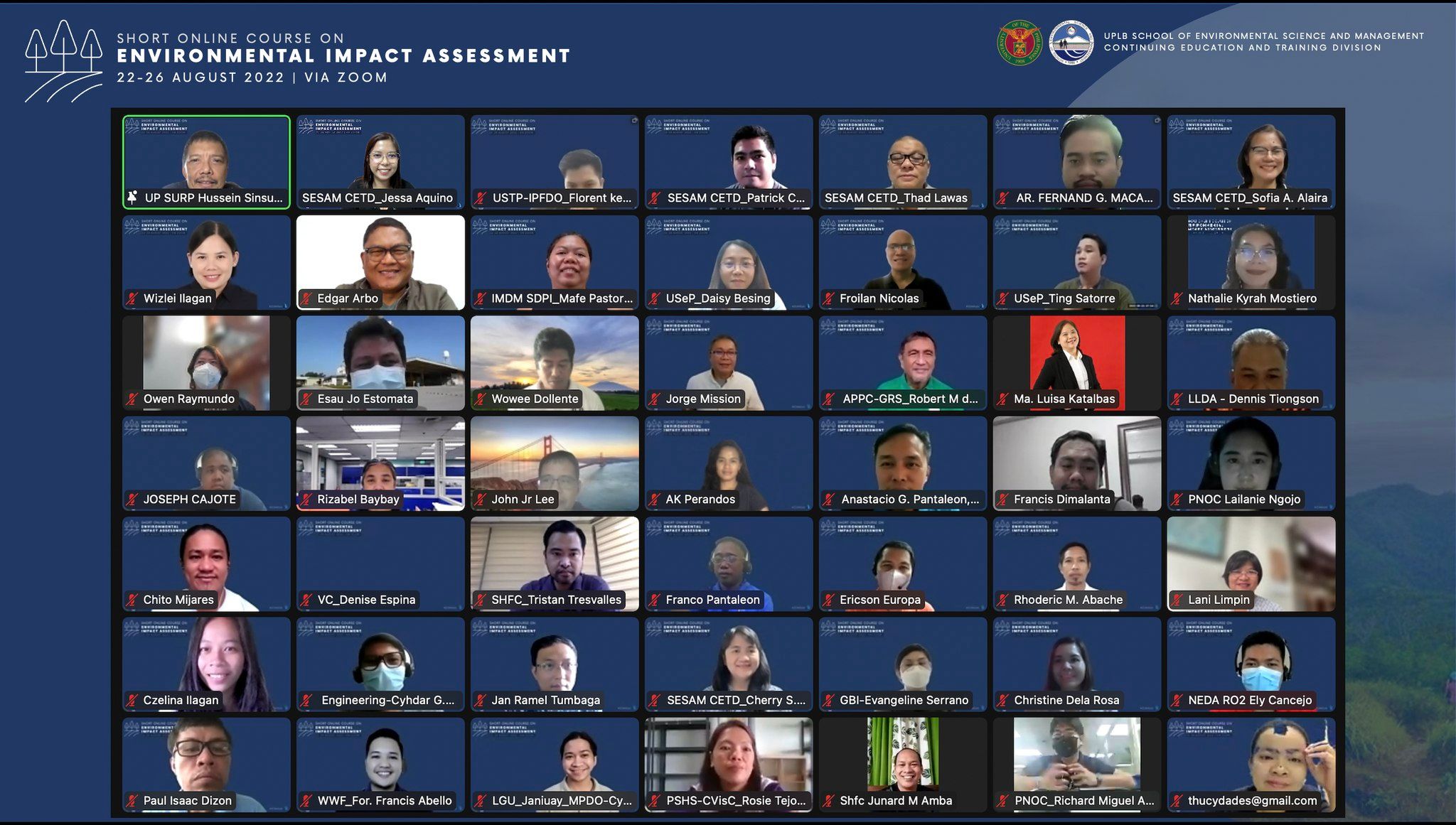
The School of Environmental Science and Management through its Continuing Education and Training Division (SESAM-CETD) successfully concluded its short online course on Environmental Impact Assessment (EIA) 2022 last August 22 to 26, 2022 via Zoom.
This is the 4th rendition of the EIA training being organized by CETD, which started via face-to-face in 2019. In 2020, SESAM-CETD collaborated with Isabela State University via Zoom, with 50 participants. Meanwhile, there were 65 participants in 2021. This year, a total of 103 participants joined the EIA online course, the highest number of registrants so far.
Among the 103 participants, 30.1% was from the academe; 22.3% from national government agencies and government owned and controlled corporations; 8.7% from the local government units; 18.4% from private institutions; and 20.5% from non-government organizations and environmental practitioners. This clearly signifies that growing demand on EIA training from various sectors and interests that SESAM must serve.
This short online course on EIA aims to provide participants with knowledge about the technical aspects and administrative procedures of the Philippine EIS System; discuss the key elements of the current EIA procedures and processes, including the existing laws and policies relevant to the conduct of EIA impart knowledge on how to identify and predict the impacts of proposed development projects and programs relevant to the fields of specialization of the participants; strengthen the technical capabilities of the participants in environmental management, especially in environmental compliance and monitoring; enhancethe participants’ skills and knowledge on how to conduct an Environmental Impact Assessment (EIA); andprovide a better appreciation of the application of science in the methods of EIA preparation.
Aside from University of the Philippines Los Baños (UPLB), other speakers from government agencies and universities were invited to lecture on various topics related to EIA. Among those invited from UPLB-SESAM were: Dr. Decibel F. Eslava (Biophysical Assessment: Geology, Soil, and Land Use); Dr. Alma Lorelei D. Abejero (EIA in the Context of Sustainable Development and Air and Climate); Dr. Loucel E. Cui (water Quality and Aquatic Biodiversity Assessment); Dr. Patricia Ann J. Sanchez (Water Quantity); Dr. Badi R. Samaniego (marine Ecosystem Assessment); Dr. Evaristo Niño T. Cando III (Social Impact Assessment and Health Impact Assessment); Dr. Eduardo C. Calzeta (Climate Change); Dr. Rico C. Ancog (Resource Economics Assessment); Dr. Marisa J. Sobremisana (Environmental Risk Assessment); Dr. Nicomedes D. Briones (EMP and EMoP).
Speakers invited from the Department of Environment and Natural Resources-Environmental Management Bureau (DENR-EMB) were Engr. Divina Camarao, Chief of EIA Section (Introduction and Overview of PEISS and EIA: EIA as a Planning, Management, and Regulatory Tool and Laws, Policies and Institutional Arrangements for EIA System) and For. Riza C. Arjona, Senior Environmental Management Specialist (Categories of EIA and EIA Process and Decision-Making). Dr. Pastor Malabrigo of the College of Forestry and Natural Resources (CFNR), UPLB was again invited to discuss terrestrial biodiversity. On the last day of the training, Dr. Hussein S. Lidasan of the School of Urban and Rural Planning (SURP), UP Diliman lectured on review of EIA quality and decision-making.
Dr. Lidasan also provided the critique of the workshop outputs of the participants, as they were divided into four groups. The four groups were given one topic each, which include expressway, quarry, reclamation and hydropower. In the workshop outputs, all the stages of the EIA process were presented, from project proposals to submission to EMB, Screening (Cat A- ECPS; Cat B-ECAs, Cat C-enhances the Environment or addresses the Environmental problem and Cat. D- not covered projects); conduct of IEC (information, education and communication); Scoping (technical to public scoping); baseline data gathering on Land, Air, Water and People, including SIA, HIA (updated); TIA, ERA, Carrying capacity, technical review, public hearing requirements, decision-making, ECC release and monitoring/implementation.
According to one of the participants, Ms. Leilani Limpin, a private environmental practitioner, the training met her expectations of gaining knowledge in environmental impact statement and environmental impact assessment preparations. For his part, Mr. Francis Joseph T. Abello, non-government organization worker, the training helped his capacity in project monitoring and evaluation. With SESAM’s mandate on environmental education, research, and extension, CETD will continue to provide quality training courses such as the EIA. CETD will offer another next short online course on climate and disaster risk assessment (CDRA) on November 2022, via online conferencing.

